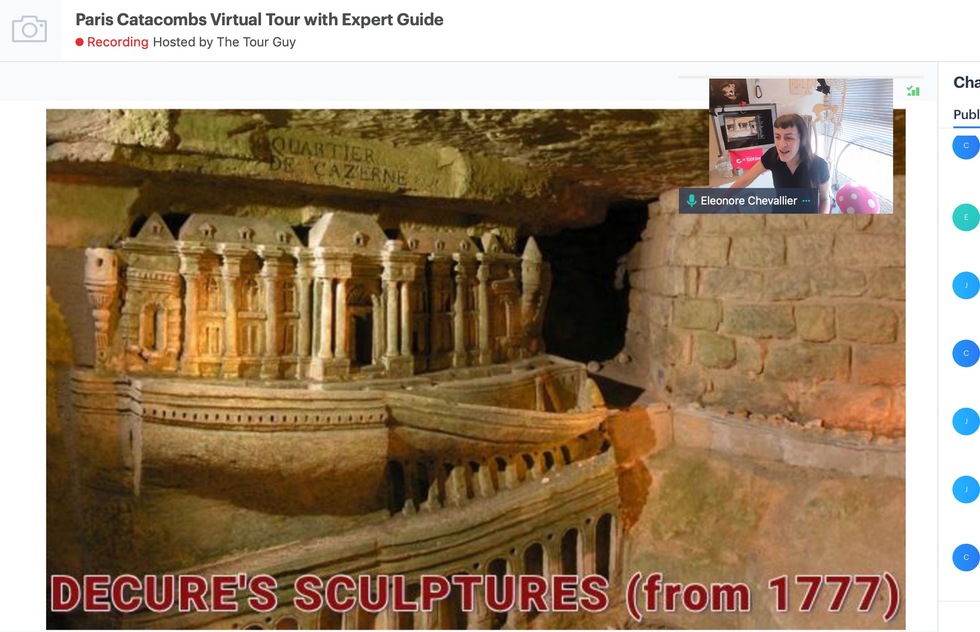"Thank you for your booking," says my new tour guide, Eleonore. "Thanks to your presence here, I am able to go back to work. I am very happy."
Then we descend 60 feet below the streets of Paris to explore the ancient labyrinth of the city's famous Catacombs.
We're not physically together, of course. We're connected by a webinar platform called BigMarker. I can see and hear Eleonore, but she can't see me.
A so-called "cataphile," Eleonore normally spends her days roaming the 1,000-odd acres of dark, dank tunnels beneath the City of Light. For four years, she has been leading in-person tours that Paris vacationers can ordinarily reserve through The Tour Guy.
But today, from her Paris apartment, Eleonore shows me the far reaches of the city's subterranean burial grounds using her own cleverly designed presentation (in English) combining her collection of photographs, video, and personal stories.
Countless tourism bureaus and visitor centers are promoting what they call "virtual tours" of their destinations. Upon closer inspection, you'll find that most of those offerings are short, pretaped marketing videos. Some of them are very well produced—like this one featuring drone footage of Pompeii from the Italian Ministry of Cultural Heritage and Activities—but the effect is passive. If you have questions, there's no one to ask.
Compare those to this new, living-and-breathing (though still virtual) tour trend.
Although the Tour Guy uses third-party software to enable the presentation, the tours are created and led in-house by the agency's experts. Eleonore likes to toss in some quick-fire polls that guests can answer with a click. One is: How many skeletons were re-interred in the Catacombs when the city's medieval cemeteries were cleared to make way for development?
Most of her questions have no wrong answers since they're intended mostly as a way to bring in new fun facts. In this case, we learned that a whopping 6 million skeletons are stacked up inside the Catacombs. That's three times the living population of Paris above.
Visiting the caverns in real life can be terrifying, claustrophobic, and unfriendly to people with mobility concerns, so this kind of tour opens the attraction to countless people even if they weren't in isolation. Thanks to the Tour Guy presentation, we tourists can stay in our pajamas, creeping past piles of ancient skulls and leg bones that line the dripping, hand-dug corridors.
The experiment seems to be working: Options for virtual tours are expanding rapidly. The Tour Guy's new virtual tour choices include explications of the royal French palace of Versailles, Gaudí's Barcelona, and Rome's Colosseum, as well as cooking demonstrations that are mounted four times a week.
Another well-established walking tour company, Take Walks, has inaugurated its own slate of live regular events, called Tours from Home, using the Zoom teleconferencing platform. Its topics include the Vatican's Sistine Chapel, the Changing of the Guard in London, and a video pizza-making class led by Italian chefs.
The Faroe Islands, north of Scotland, have made this idea official. Every day, a local with a camera shows online viewers the lay of the land for an hour a day, taking requests from viewers in the form of a Nintendo-like hand controller on the screen. Since it's designed to promote the destination, the virtual tour is free.
Airbnb, too, has refocused some of its Experiences, which are usually add-ons to vacation rental reservations, to become virtual tours. In that website's case, the tours are not devised in-house; as with home rental listings, each tour is offered by an independent operator who uses the Airbnb platform for distribution.
Prices for all the new tours are not high. They tend to start at around $10 per session and top out around $17, and choices are expanding weekly.
Like regular walking tours, these are not conducted on demand but follow a set schedule. But happily, most timings are designed to align with the North American clock: During the tour with Eleonore, we could hear the cheers and whistles for the emergency workers that fill Parisian streets each night at 8pm, but it was 2pm in New York and 11am in Los Angeles.
Midway thorough our 75-minute session, as Eleonore related a harrowing story of a portly amateur cataphile who got stuck for six hours in a tiny passageway amid the bones, I sent the "dizzy" emoji to her in the chat window.
"I can't see you, so I like that," she said. At the tour's end, Eleonore lingered for questions.
Even in their first weeks of development, virtual walking tours are an effective tool for learning and for imparting the feel of travel.
Maybe the world's walking tour guides have stumbled, if that's the word, on a mode of exploration that we can enjoy from home even after life gets back to normal.






